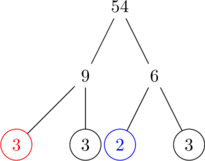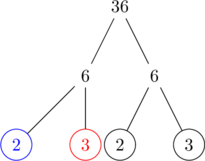6.4 Greatest Common Factor and Factor by Grouping
Learning Objectives
By the end of this section, you will be able to:
- Find the greatest common factor of two or more expressions
- Factor the greatest common factor from a polynomial
- Factor by grouping
Find the Greatest Common Factor of Two or More Expressions
Earlier we multiplied factors together to get a product. Now, we will be reversing this process; we will start with a product and then break it down into its factors. Splitting a product into factors is called factoring.
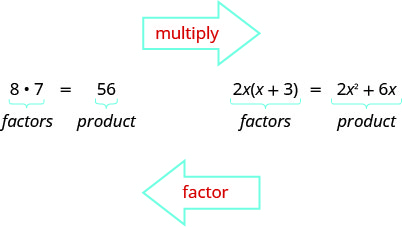
We have learned how to factor numbers to find the least common multiple (LCM) of two or more numbers. Now we will factor expressions and find the greatest common factor of two or more expressions. The method we use is similar to what we used to find the LCM.
Greatest Common Factor
The greatest common factor (GCF) of two or more expressions is the largest expression that is a factor of all the expressions.
First we’ll find the GCF of two numbers.
EXAMPLE 1
Find the GCF of 54 and 36
| Step 1. Factor each coefficient into prime numbers. Write all the variables with exponents in expanded form | Factor 54 and 36 |
|
|
|
||
| Step 2. In each column, circle the common factors. | Circle the 2,3, and 3 that are shared by both numbers. |
|
| Step 3. Bring down the common factors that all expressions share. | Bring down the 2,3, and 3, and then multiply. | GCF = |
| Step 4. Multiply the factors. |
GCF = 18 The GCF of 54 and 36 is 18 |
Notice that, because the GCF is a factor of both numbers, 54 and 36 can be written as multiples of 18
TRY IT 1.1
Find the GCF of 48 and 80.
Show answer
16
TRY IT 1.2
Find the GCF of 18 and 40.
Show answer
2
We summarize the steps we use to find the GCF below.
HOW TO:
Find the Greatest Common Factor (GCF) of two expressions
- Factor each coefficient into primes. Write all variables with exponents in expanded form.
- List all factors—matching common factors in a column. In each column, circle the common factors.
- Bring down the common factors that all expressions share.
- Multiply the factors.
In the first example, the GCF was a constant. In the next two examples, we will get variables in the greatest common factor.
EXAMPLE 2
Find the greatest common factor of ![]() and
and ![]() .
.
| Factor each coefficient into primes and write the variables with exponents in expanded form. Circle the common factors in each column. |
|
| Bring down the common factors. | GCF = |
| Multiply the factors. | GCF |
| The GCF of |
|
TRY IT 2.1
Find the GCF: ![]() .
.
Show answer
![]()
TRY IT 2.2
Find the GCF: ![]() .
.
Show answer
![]()
EXAMPLE 3
Find the GCF of ![]() .
.
| Factor each coefficient into primes and write the variables with exponents in expanded form. Circle the common factors in each column. | |
| Bring down the common factors. | |
| Multiply the factors. | |
| The GCF of |
|
TRY IT 3.1
Find the GCF: ![]() .
.
Show answer
![]()
TRY IT 3.2
Find the GCF: ![]() .
.
Show answer
![]()
EXAMPLE 4
Find the GCF of: ![]() .
.
| Factor each coefficient into primes and write the variables with exponents in expanded form. Circle the common factors in each column. |  |
| Bring down the common factors. | |
| Multiply the factors. | |
| The GCF of |
|
TRY IT 4.1
Find the greatest common factor: ![]() .
.
Show answer
![]()
TRY IT 4.2
Find the greatest common factor: ![]() .
.
Show answer
![]()
Factor the Greatest Common Factor from a Polynomial
Just like in arithmetic, where it is sometimes useful to represent a number in factored form (for example, 12 as ![]() or
or ![]() , in algebra, it can be useful to represent a polynomial in factored form. One way to do this is by finding the GCF of all the terms. Remember, we multiply a polynomial by a monomial as follows:
, in algebra, it can be useful to represent a polynomial in factored form. One way to do this is by finding the GCF of all the terms. Remember, we multiply a polynomial by a monomial as follows:

Now we will start with a product, like ![]() , and end with its factors,
, and end with its factors, ![]() . To do this we apply the Distributive Property “in reverse.”
. To do this we apply the Distributive Property “in reverse.”
We state the Distributive Property here just as you saw it in earlier chapters and “in reverse.”
Distributive Property
If ![]() are real numbers, then
are real numbers, then
The form on the left is used to multiply. The form on the right is used to factor.
So how do you use the Distributive Property to factor a polynomial? You just find the GCF of all the terms and write the polynomial as a product!
EXAMPLE 5
Factor: ![]() .
.
| Step 1. Find the GCF of all the terms of the polynomial. | Find the GCF of and 12 . |  |
| Step 2. Rewrite each term as a product using the GCF. | Rewrite
|
|
|
Step 3. Use the “reverse” Distributive Property to
factor the expression. |
||
| Step 4. Check by multiplying the factors. |  |
TRY IT 5.1
Factor: ![]() .
.
Show answer
![]()
TRY IT 5.2
Factor: ![]() .
.
Show answer
![]()
HOW TO:
Factor the greatest common factor from a polynomial.
- Find the GCF of all the terms of the polynomial.
- Rewrite each term as a product using the GCF.
- Use the “reverse” Distributive Property to factor the expression.
- Check by multiplying the factors.
We use “factor” as both a noun and a verb.

EXAMPLE 6
Factor: ![]() .
.
| Find the GCF of 5a and 5. |  |
| Rewrite each term as a product using the GCF. | |
| Use the Distributive Property “in reverse” to factor the GCF. | |
| Check by multiplying the factors to get the original polynomial. |  |
TRY IT 6.1
Factor: ![]() .
.
Show answer
![]()
TRY IT 6.1
Factor: ![]() .
.
Show answer
![]()
The expressions in the next example have several factors in common. Remember to write the GCF as the product of all the common factors.
EXAMPLE 7
Factor: ![]() .
.
| Find the GCF of |
 |
| Rewrite each term as a product using the GCF. | |
| Factor the GCF. | |
| Check by multiplying the factors. |  |
TRY IT 7.1
Factor: ![]() .
.
Show answer
![]()
TRY IT 7.2
Factor: ![]() .
.
Show answer
![]()
Now we’ll factor the greatest common factor from a trinomial. We start by finding the GCF of all three terms.
EXAMPLE 8
Factor: ![]() .
.
We start by finding the GCF of all three terms.
| Find the GCF of |
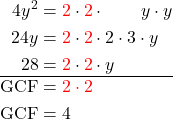 |
| Rewrite each term as a product using the GCF.
Factor the GCF. |
 |
| Factored result. | |
| Check by multiplying. |  |
TRY IT 8.1
Factor: ![]() .
.
Show answer
![]()
TRY IT 8.2
Factor: ![]() .
.
Show answer
![]()
EXAMPLE 9
Factor: ![]() .
.
| Find the GCF of |
 |
| Rewrite each term. | |
| Factor the GCF. | |
| Check. |  |
TRY IT 9.1
Factor: ![]() .
.
Show answer
![]()
TRY IT 9.2
Factor: ![]() .
.
Show answer
![]()
EXAMPLE 10
Factor: ![]() .
.
In a previous example we found the GCF of ![]() to be
to be ![]() .
.
| Rewrite each term using the GCF, 3x. | |
| Factor the GCF. | |
| Check. |  |
TRY IT 10.1
Factor: ![]() .
.
Show answer
![]()
TRY IT 10.2
Factor: ![]() .
.
Show answer
![]()
EXAMPLE 11
Factor: ![]() .
.
| Find the GCF of |
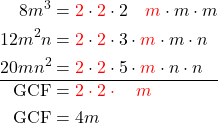 |
| Rewrite each term. | |
| Factor the GCF. | |
| Check. |  |
TRY IT 11.1
Factor: ![]() .
.
Show answer
![]()
TRY IT 11.2
Factor: ![]() .
.
Show answer
![]()
When the leading coefficient is negative, we factor the negative out as part of the GCF.
EXAMPLE 12
Factor: ![]() .
.
When the leading coefficient is negative, the GCF will be negative.
|
Ignoring the signs of the terms, we first find the GCF of Since the expression |
 |
| Rewrite each term using the GCF. | |
| Factor the GCF. | |
| Check. |  |
TRY IT 12.1
Factor: ![]() .
.
Show answer
![]()
TRY IT 12.2
Factor: ![]() .
.
Show answer
![]()
EXAMPLE 13
Factor: ![]() .
.
The leading coefficient is negative, so what will be the sign of the GCF?
| Ignoring the signs of the terms, we first find the GCF of
Since the leading coefficient is negative, the GCF is negative |

|
| Rewrite each term using the GCF. *this is an important step, ask your instructor to explain it if you need help with it. |
|
| Factor the GCF. | |
| Check. |  |
TRY IT 13.1
Factor: ![]() .
.
Show answer
![]()
TRY IT 13.2
Factor: ![]() .
.
Show answer
![]()
EXAMPLE 14
Factor: ![]() .
.
| Find the GCF of The GCF is the binomial |
 |
| Factor the GCF, |
|
| Check by multiplying using Distributive law to distribute the binomial |
TRY IT 14.1
Factor: ![]() .
.
Show answer
![]()
TRY IT 14.2
Factor: ![]() .
.
Show answer
![]()
Factor by Grouping
When there is no common factor of all the terms of a polynomial, look for a common factor in just some of the terms. When there are four terms, a good way to start is by separating the polynomial into two parts with two terms in each part. Then look for the GCF in each part. If the polynomial can be factored, you will find a common factor emerges from both parts.
(Not all polynomials can be factored. Just like some numbers are prime, some polynomials are prime.)
EXAMPLE 15
Factor: ![]() .
.
| Step 1. Group terms with common factors. |
Is there a greatest common factor of all four terms? No, so let’s separate the first two terms from the second two. |
|
| Step 2. Factor out the common factor in each group.
|
Factor the GCF from the first two terms. |
 |
| Step 3. Factor the common factor from the expression. |
Notice that each term has a common factor of |
|
| Step 4. Check. | Multiply Is the product the original expression? |
 |
TRY IT 15.1
Factor: ![]() .
.
Show answer
![]()
TRY IT 15.2
Factor: ![]() .
.
Show answer
![]()
HOW TO:
Factor by grouping.
- Group terms with common factors.
- Factor out the common factor in each group.
- Factor the common factor from the expression.
- Check by multiplying the factors.
EXAMPLE 16
Factor: ![]() .
.
Solution
| There is no GCF in all four terms. | |
| Separate into two parts. | |
| Factor the GCF from both parts. Be careful with the signs when factoring the GCF from the last two terms. | |
| Check on your own by multiplying. |
TRY IT 16.1
Factor: ![]() .
.
Show answer
![]()
TRY IT 16.2
Factor: ![]() .
.
Show answer
![]()
Access these online resources for additional instruction and practice with greatest common factors (GFCs) and factoring by grouping.
Key Concepts
- Finding the Greatest Common Factor (GCF): To find the GCF of two expressions:
- Factor each coefficient into primes. Write all variables with exponents in expanded form.
- List all factors—matching common factors in a column. In each column, circle the common factors.
- Bring down the common factors that all expressions share.
- Multiply the factors.
- Factor the Greatest Common Factor from a Polynomial: To factor a greatest common factor from a polynomial:
- Find the GCF of all the terms of the polynomial.
- Rewrite each term as a product using the GCF.
- Use the ‘reverse’ Distributive Property to factor the expression.
- Check by multiplying the factors.
- Factor by Grouping: To factor a polynomial with 4 or more terms
- Group terms with common factors.
- Factor out the common factor in each group.
- Factor the common factor from the expression.
- Check by multiplying the factors.
Glossary
- factoring
- Factoring is splitting a product into factors; in other words, it is the reverse process of multiplying.
- greatest common factor
- The greatest common factor is the largest expression that is a factor of two or more expressions is the greatest common factor (GCF).
Type your textbox content here.
Practice Makes Perfect
Find the Greatest Common Factor of Two or More Expressions
In the following exercises, find the greatest common factor.
| 1. 8, 18 | 2. 24, 40 |
| 3. 72, 162 | 4. 150, 275 |
| 5. 10a, 50 | 6. 5b, 30 |
| 7. |
8. |
| 9. |
10. |
| 11. |
12. |
| 13. |
14. |
| 15. |
16. |
| 17. |
18. |
Factor the Greatest Common Factor from a Polynomial
In the following exercises, factor the greatest common factor from each polynomial.
| 19. |
20. |
| 21. |
22. |
| 23. |
24. |
| 25. |
26. |
| 27. |
28. |
| 29. |
30. |
| 31. |
32. |
| 33. |
34. |
| 35. |
36. |
| 37. |
38. |
| 39. |
40 |
| 41. |
42. |
| 43. |
44. |
Factor by Grouping
In the following exercises, factor by grouping.
| 45. |
46. |
| 47. |
48. |
| 49. |
50. |
| 51. |
52. |
Mixed Practice
In the following exercises, factor.
| 53. |
54. |
| 55. |
56. |
| 57. |
58. |
Everyday Math
| 59. Area of a rectangle The area of a rectangle with length 6 less than the width is given by the expression |
60. Height of a baseball The height of a baseball t seconds after it is hit is given by the expression |
Writing Exercises
| 61. The greatest common factor of 36 and 60 is 12. Explain what this means. | 62. What is the GCF of |
Answers
| 1. 2 | 3. 18 |
| 5. 10 | 7. |
| 9. |
11. |
| 13. |
15. |
| 17. |
19. |
| 21. |
23. |
| 25. |
27. |
| 29. |
31. |
| 33. |
35. |
| 37. |
39. |
| 41. |
43. |
| 45. |
47. |
| 49. |
51. |
| 53. |
55. |
| 57. |
59. |
| 61. Answers will vary. |
Attributions
This chapter has been adapted from “Greatest Common Factor and Factor by Grouping” in Elementary Algebra (OpenStax) by Lynn Marecek and MaryAnne Anthony-Smith, which is under a CC BY 4.0 Licence. Adapted by Izabela Mazur. See the Copyright page for more information.

